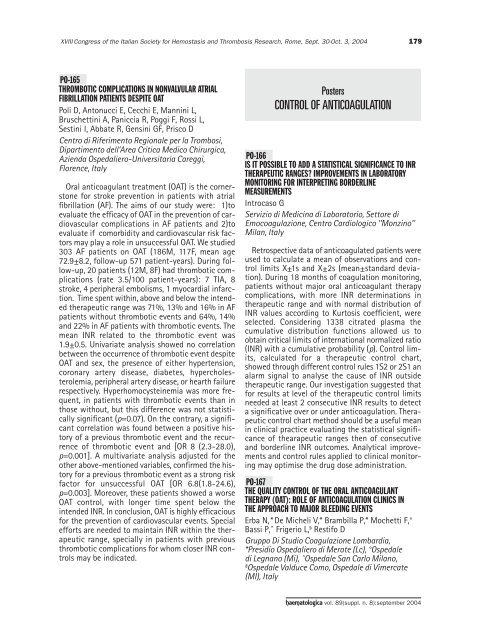Haematologica 2004;89: supplement no. 8 - Supplements ...
Haematologica 2004;89: supplement no. 8 - Supplements ...
Haematologica 2004;89: supplement no. 8 - Supplements ...
- No tags were found...
Create successful ePaper yourself
Turn your PDF publications into a flip-book with our unique Google optimized e-Paper software.
XVIII Congress of the Italian Society for Hemostasis and Thrombosis Research, Rome, Sept. 30-Oct. 3, <strong>2004</strong>179PO-165THROMBOTIC COMPLICATIONS IN NONVALVULAR ATRIALFIBRILLATION PATIENTS DESPITE OATPoli D, Antonucci E, Cecchi E, Mannini L,Bruschettini A, Paniccia R, Poggi F, Rossi L,Sestini I, Abbate R, Gensini GF, Prisco DCentro di Riferimento Regionale per la Trombosi,Dipartimento dell’Area Critica Medico Chirurgica,Azienda Ospedaliero-Universitaria Careggi,Florence, ItalyOral anticoagulant treatment (OAT) is the cornerstonefor stroke prevention in patients with atrialfibrillation (AF). The aims of our study were: 1)toevaluate the efficacy of OAT in the prevention of cardiovascularcomplications in AF patients and 2)toevaluate if comorbidity and cardiovascular risk factorsmay play a role in unsuccessful OAT. We studied303 AF patients on OAT (186M, 117F, mean age72.9±8.2, follow-up 571 patient-years). During follow-up,20 patients (12M, 8F) had thrombotic complications(rate 3.5/100 patient-years): 7 TIA, 8stroke, 4 peripheral embolisms, 1 myocardial infarction.Time spent within, above and below the intendedtherapeutic range was 71%, 13% and 16% in AFpatients without thrombotic events and 64%, 14%and 22% in AF patients with thrombotic events. Themean INR related to the thrombotic event was1.9±0.5. Univariate analysis showed <strong>no</strong> correlationbetween the occurrence of thrombotic event despiteOAT and sex, the presence of either hypertension,coronary artery disease, diabetes, hypercholesterolemia,peripheral artery disease, or hearth failurerespectively. Hyperhomocysteinemia was more frequent,in patients with thrombotic events than inthose without, but this difference was <strong>no</strong>t statisticallysignificant (p=0.07). On the contrary, a significantcorrelation was found between a positive historyof a previous thrombotic event and the recurrenceof thrombotic event and [OR 8 (2.3-28.0),p=0.001]. A multivariate analysis adjusted for theother above-mentioned variables, confirmed the historyfor a previous thrombotic event as a strong riskfactor for unsuccessful OAT [OR 6.8(1.8-24.6),p=0.003]. Moreover, these patients showed a worseOAT control, with longer time spent below theintended INR. In conclusion, OAT is highly efficaciousfor the prevention of cardiovascular events. Specialefforts are needed to maintain INR within the therapeuticrange, specially in patients with previousthrombotic complications for whom closer INR controlsmay be indicated.PostersCONTROL OF ANTICOAGULATIONPO-166IS IT POSSIBLE TO ADD A STATISTICAL SIGNIFICANCE TO INRTHERAPEUTIC RANGES? IMPROVEMENTS IN LABORATORYMONITORING FOR INTERPRETING BORDERLINEMEASUREMENTSIntrocaso GServizio di Medicina di Laboratorio, Settore diEmocoagulazione, Centro Cardiologico ''Monzi<strong>no</strong>''Milan, ItalyRetrospective data of anticoagulated patients wereused to calculate a mean of observations and controllimits X±1s and X±2s (mean±standard deviation).During 18 months of coagulation monitoring,patients without major oral anticoagulant therapycomplications, with more INR determinations intherapeutic range and with <strong>no</strong>rmal distribution ofINR values according to Kurtosis coefficient, wereselected. Considering 1338 citrated plasma thecumulative distribution functions allowed us toobtain critical limits of international <strong>no</strong>rmalized ratio(INR) with a cumulative probability (p). Control limits,calculated for a therapeutic control chart,showed through different control rules 1S2 or 2S1 analarm signal to analyse the cause of INR outsidetherapeutic range. Our investigation suggested thatfor results at level of the therapeutic control limitsneeded at least 2 consecutive INR results to detecta significative over or under anticoagulation. Therapeuticcontrol chart method should be a useful meanin clinical practice evaluating the statistical significanceof thearapeutic ranges then of consecutiveand borderline INR outcomes. Analytical improvementsand control rules applied to clinical monitoringmay optimise the drug dose administration.PO-167THE QUALITY CONTROL OF THE ORAL ANTICOAGULANTTHERAPY (OAT): ROLE OF ANTICOAGULATION CLINICS INTHE APPROACH TO MAJOR BLEEDING EVENTSErba N,* De Micheli V,* Brambilla P,* Mochetti F,°Bassi P,^ Frigerio L, § Restifo DGruppo Di Studio Coagulazione Lombardia,*Presidio Ospedaliero di Merate (Lc), °Ospedaledi Legna<strong>no</strong> (Mi), ^Ospedale San Carlo Mila<strong>no</strong>,§Ospedale Valduce Como, Ospedale di Vimercate(MI), Italyhaematologica vol. <strong>89</strong>(suppl. n. 8):september <strong>2004</strong>
















